More Databases Linked & Search Improvements for Scientific Names
July 9th, 2024 by Alex Zorach
Since our last post about interlinking databases, we have interlinked four more databases, each of which is now shown in the external links at the bottom of each plant page. We also added a new feature for when you search by scientific name but no results are found. In this case we now run a second search of linked external records, which in many cases will return useful results.This blog post first highlights the newly linked databases and then explains how the search improvements work.
Missouri Plants
We have already been interlinked with the Missouri Botanical Garden's (MOBOT's) Plant Finder for a long time, but Missouri Plants, unaffiliated with MOBOT, is something completely different. Whereas MOBOT focuses on horticultural cultivars and the use of plants in landscaping and gardening, Missouri Plants is, more like us, focused on plants in the wild.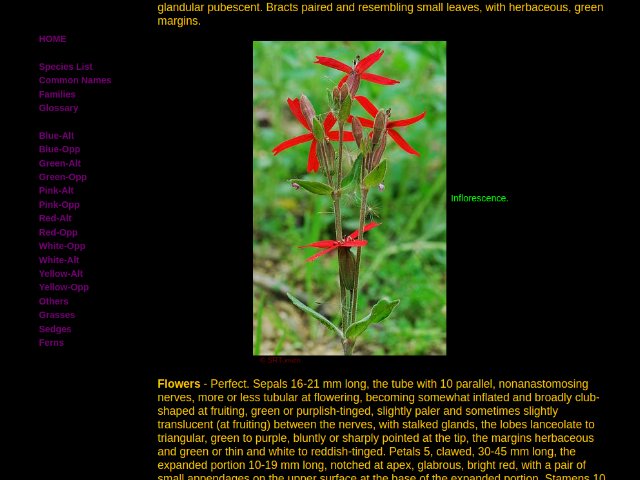 This screenshot shows the page for fire pink (Silene virginica) on the Missouri Plants website. This page has a detailed botanical description accompanied by photos.
This screenshot shows the page for fire pink (Silene virginica) on the Missouri Plants website. This page has a detailed botanical description accompanied by photos.The website can be seen as an online continuation of the print book Flora of Missouri by George Yatskievych (1999) which was itself an update of the original Flora of Missouri by Julian Steyermark (1963).
On each page you will find photos, basic information on the plant's habitat in the state, and a botanical description, extensive on some pages, often accompanied by numerous illustrating pictures. The photography is outstanding for illustrating key identification features. The pages also note flowering periods, origin (native vs. introduced), and mention common lookalikes. The site makes an excellent addition to our linked resources and will be particularly useful for people in or near Missouri. Because of the emphasis on botanical descriptions and identification, we also display Missouri Plants pages in the list of references and links on our ID / Comparison guides.
Maryland Biodiversity Project
Maryland Biodiversity Project (MBP) is another exciting project that we have referenced before in our blog posts. We have been using it to construct range maps for a long time, but we only interlinked it recently. Although MBP covers other organisms besides plants, such as fungi and animals, we only link its plant pages. MBP is run by its own non-profit organization.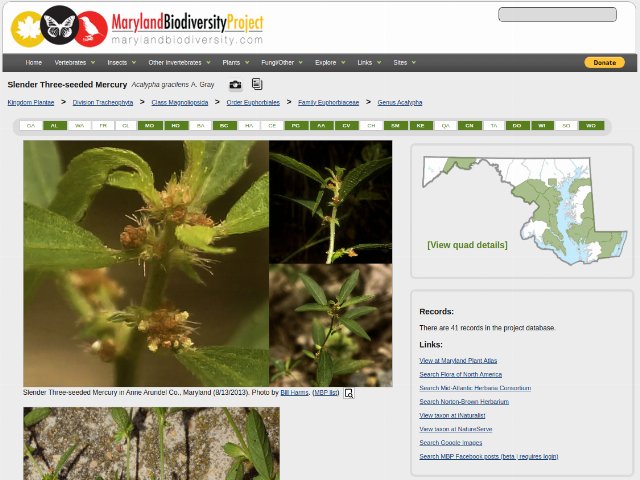 This screenshot shows Maryland Biodiversity Project's page on slender three-seeded mercury (Acalypha gracilens). MBP's map for this species shows several counties beyond those reported in BONAP, which itself improved over the missing county-level data for MD in the USDA PLANTS database.
This screenshot shows Maryland Biodiversity Project's page on slender three-seeded mercury (Acalypha gracilens). MBP's map for this species shows several counties beyond those reported in BONAP, which itself improved over the missing county-level data for MD in the USDA PLANTS database.The most valuable materials to us on MBP's site are its county-level maps, which fill a key data gap. The USDA PLANTS database is missing county-level data for Maryland for most plants, and BONAP has only slightly improved on this major shortcoming. MBP however is quite comprehensive; although there are still limits to its data, we have found it to have the most accurate and comprehensive county-level data on plant distribution in Maryland. The site also shows a finer-level of plant distribution using grids smaller than most counties.
Besides distribution data, MBP also has high-resolution photographs on most pages. Some pages also have comments on taxonomy. There is a list of links but we emphasize that the links are auto-generated by scientific name, not manually-reviewed as we do for our external links.
Minnesota Wildflowers
Minnesota Wildflowers, unlike its name suggests, covers all sorts of plants that occur in the wild in Minnesota, even woody and non-flowering plants such as conifers. The website is run by a non-profit and, much like bplant.org, has an extraordinarily lean budget relative to the extent of the work it does.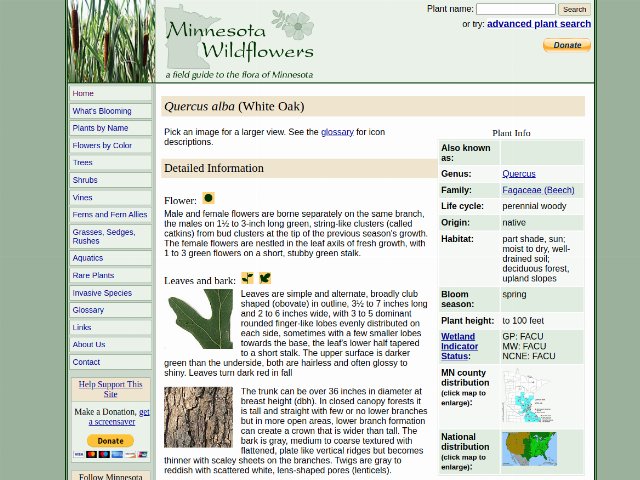 This screenshot shows Minnesota Wildflower's page on Quercus alba (white oak). The existence of this page demonstrates that this website covers more than just wildflowers.
This screenshot shows Minnesota Wildflower's page on Quercus alba (white oak). The existence of this page demonstrates that this website covers more than just wildflowers.Each page features botanical descriptions, usually accompanied by photos. There is more emphasis on identification than on most sites, and there is typically an extensive verbal explanation of how to distinguish each species from other visually-similar species. As such, we also added this resource to the references and links on each ID / Comparison guide whenever there is a corresponding record on this site.
In addition to the description and identification tips, Minnesota Wildflowers has a brief description of habitat, wetland indicator status, and bloom season. It also has county-level distribution maps pinpointing specific locations within each county, reflecting herbarium records. These records are useful for us in building ecoregion range maps for many plants, like the white oak shown above, which meet their range limits in Minnesota.
Digital Atlas of the Virginia Flora
The Digital Atlas of the Virginia Flora, which can be referred to more concisely by its domain vaplantatlas.org, is our most recently-interlinked database. It is an outgrowth of the Flora of Virginia Project, which was published as a book from 1997 to 1992, and grew into an online Atlas of the Virginia Flora before the current iteration of the website.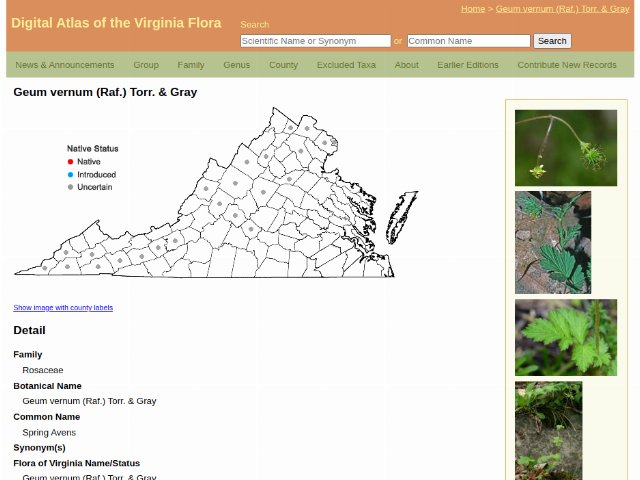 vaplantatlas.org's page on Geum vernum shows uncertainty about this plant's status as native vs. introduced. Our page on spring avens (Geum vernum) similarly denotes this uncertainty.
vaplantatlas.org's page on Geum vernum shows uncertainty about this plant's status as native vs. introduced. Our page on spring avens (Geum vernum) similarly denotes this uncertainty.Like many regional databases, vaplantatlas.org features county-level maps, but one innovation that we particularly appreciate is that their maps also denote uncertainty. The rest of the page features photos and conveys other useful information in text, such as native status, scientific synonyms, and common names. The atlas also has separate records on subspecies or varieties.
What stands out the most to us about vaplantatlas.org is the depth of its habitat description for many taxa, often having a longer paragraph instead of just a brief sentence or phrase. Some records also have extensive comments on taxonomy, discussing reclassifications or other changes, identification issues, and other considerations. The combination of these two fields has made this site especially helpful in researching habitat and taxonomy alike.
Search Improvements
We face the ongoing problem that many plants have been reclassified, sometimes multiple times, and different authorities can refer to the same taxon by different scientific names. Synonymy (listing scientific synonyms) mostly addresses this issue as far as online search is concerned: a search for any listed synonyms will return a link to the taxon, and show the preferred name, which in most cases corresponds to the name used by POWO (Plants of the World Online.)The problem is that the process of listing synonyms exhaustively is resource-intensive. In some cases, there is controversy of which synonyms to list, with different authorities using different classification schemes. Because taxonomy can be both confusing and controversial, we like to manually check each name instead of using an automated process to add them. So there are many synonyms which we have not yet listed. As such, when you type these names in, they may return no results in our search, even if they refer to a taxon which we already have listed on our site under another name.
To partly alleviate this shortcoming, we have added a new feature to our search. Now, whenever a scientific name returns no search results, we then run a search of unlinked records in all our interlinked dabatases and external websites. This query is carried out on our own database, not the websites themselves, so it represents a snapshot of the records on each website pulled at a certain time in the past, not a real-time search of the other websites. But in many cases, it will return records even when the same name does not return any results on our site.
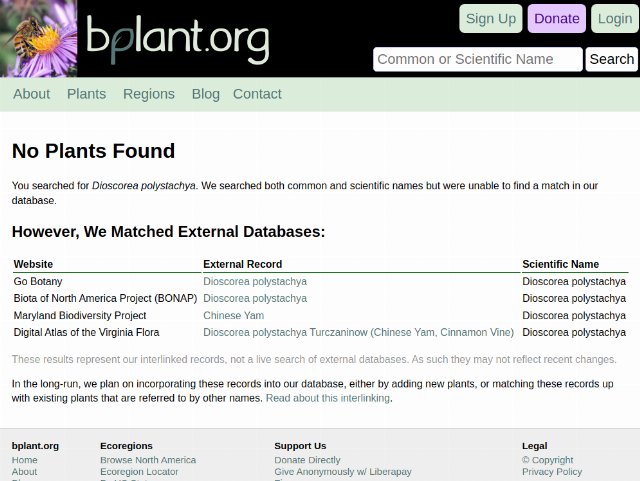 This screenshot shows a search for the scientific name Dioscorea polystachya. Because our original plant list was pulled from the USDA PLANTS database, we pulled all errors in that dataset. One error was that the introduced plant properly called Dioscorea polystachya Turcz. was wrongly referred to as Dioscorea oppositifolia L., an error common in older sources. Although Dioscorea oppositifolia L. is an actual species, modern authorities agree that it is not found anywhere in North America. Before we resolved this issue, a search for the correct name "Dioscorea polystachya" on our site would return no results. However, with the new search feature, it returns a variety of records on external sites, helping to more quickly figure out what is going on. We have corrected the error, so the search now returns the proper page.
This screenshot shows a search for the scientific name Dioscorea polystachya. Because our original plant list was pulled from the USDA PLANTS database, we pulled all errors in that dataset. One error was that the introduced plant properly called Dioscorea polystachya Turcz. was wrongly referred to as Dioscorea oppositifolia L., an error common in older sources. Although Dioscorea oppositifolia L. is an actual species, modern authorities agree that it is not found anywhere in North America. Before we resolved this issue, a search for the correct name "Dioscorea polystachya" on our site would return no results. However, with the new search feature, it returns a variety of records on external sites, helping to more quickly figure out what is going on. We have corrected the error, so the search now returns the proper page.The fallback search returns a list of records on these external sites, which you can explore yourself. You may be able to figure out what taxon the name refers to, come back to our site and either type a widely-used common name into the search, or type in a scientific synonym to find our record. Furthermore, we have set up our system so that whenever anyone conducts a search that returns no records on our site, but returns external links, it notifies us by email that the taxon needs attention, so that we can research the taxon, add the unlinked synonyms, and then link up the unlinked records so that future searches will return the proper entry.
So not only are we improving the search experience for users, but we have created a system to facilitate us quickly resolving the synonymy for taxa for which there is demand for researching or reading about. We have already used this system to detect and resolve a number of inconsistencies, such as the misapplication of a scientific name for Chinese yam given in the above screenshot.
Stay Tuned for More Progress!
As with all of our linked databases, the main interlinking is not the end of the story. All four of these databases have a number (about 100-650 each) of unmatched records which reflect plants referred to by different scientific names and/or taxa that are treated differently in the different sources. It will take us considerable time to resolve them; we haven't even resolved all the records in some of the sources we linked over a year ago. However, we are continually making progress and you will continue seeing progress on all of these interlinking projects. And the good news is that we tend to resolve these by the plant, so when they are resolved for a particular plant, we fix the links for all external records at once, and set it up so future databases will link more seamlessly.As always, you can support our work by donating, and also by sharing and linking to our site. If you run any of these websites or any website about plants, and want to interlink with us the way we have been linking to these databases, please get in touch because we would love to facilitate you doing so.
We also want to thank everyone who has continued supporting us, whether through donations or through talking about or sharing or linking to our site. We are over halfway through 2024 and this has proven to be a great year both in terms of what we've gotten done, and in terms of engagement on the site and support from our users. Thank you everyone!
And if you are looking for more projects to support, please consider donating to the organizations that run these websites, or any of the websites we link to. And certainly check them out, especially if you live in their areas of coverage!
Archive of All Blogs
The Bias Against Tall Plants, November 11th, 2025
A Focus on Goldenrods (Solidago sp.), July 23rd, 2025
Disturbance and its Role in Plant Habitat Preferences, May 29th, 2025
What "Native" or "Introduced" Mean: Myths and Misconceptions, March 11th, 2025
Smarter & More Informative Search Results, January 13th, 2025
The Effect of the 2024 US Election on Plant Biodiversity and bplant.org, October 30th, 2024
The Problems With Nursery-Bought Plants, And The Solutions, October 8th, 2024
More Databases Linked & Search Improvements for Scientific Names, July 9th, 2024
Choosing The Best Common Names For Plants: Challenges & Solutions, April 19th, 2024
Range Map & Taxonomic Update Progress, January 31st, 2024
Giving Thanks To Everyone We Rely On, November 22nd, 2023
Thinking More Deeply About Habitat, April 5th, 2023
2022 Year-End Summary: Successes & New Goals, February 15th, 2023
New Databases Linked: Flora of North America & NatureServe Explorer, November 11th, 2022
All Range Maps 2nd Generation, Taxonomic Updates, & Fundraising Goal Met!, September 29th, 2022
More Range Map Improvements, POWO Interlinking, And Notes Fields, June 7th, 2022
Ecoregion-Based Plant Lists and Search, March 30th, 2022
Progress Updates on Range Maps and More, February 10th, 2022
The Vision for bplant.org, December 9th, 2021
New Server: Software & Hardware, August 30th, 2021
More & Improved Plant Range Maps, July 19th, 2021
A Control Section for Invasive Plants, April 15th, 2021
Progress Bars & State Ecoregion Legends, March 11th, 2021
Our 2020 Achievements, February 9th, 2021
Interlinking Databases for Plant Research, November 11th, 2020
A New Homepage, Highlighting Our Articles, July 29th, 2020
A False Recovery, But North Carolina's Ecoregions are Complete!, June 9th, 2020
We're Back After COVID-19 Setbacks, April 3rd, 2020
Help Us Find Ecoregion Photos, February 27th, 2020
What We Achieved in 2019, December 30th, 2019
Plant Comparison and ID Guides, October 30th, 2019
We Are Now Accepting Donations, October 14th, 2019
US State Ecoregion Maps, New Footer, Ecoregion Article Progress, and References, September 19th, 2019
Tentative Range Maps of Native Plants, August 12th, 2019
Ecoregion Locator and Interactive Maps, July 10th, 2019
Using Ecoregions Over Political Boundaries, May 13th, 2019
How We Handle Wild vs Cultivated Plants, April 16th, 2019
A Blog To Keep People Updated On Our Progress, April 8th, 2019
Sign Up
Want to get notified of our progress? Sign up for the bplant.org interest list!


